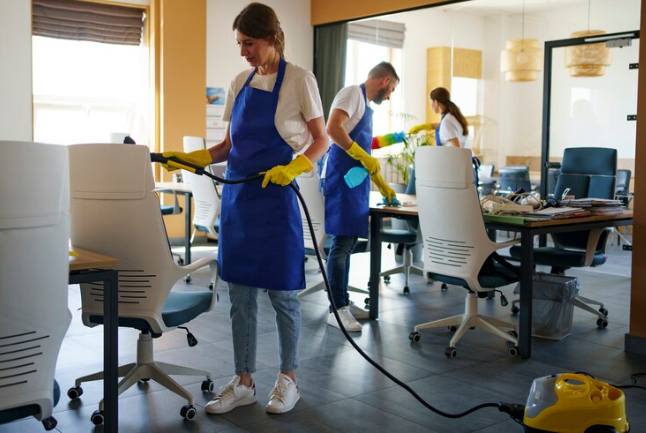It is the school’s responsibility to offer a hygienic, sanitary, and secure environment for their educators, students, and guests. Therefore, effective upkeep of a clean and tidy atmosphere in a school is crucial to stopping the threat of germs and illnesses.
However, maintaining frequent and consistent cleaning in a school setting is challenging, and the pandemic has increased the bar for cleanliness to ensure everyone’s safety.
Effective cleaning and upkeep of school buildings is hampered by several factors. This article examines some of these difficulties and offers effective solutions for maintaining a clean and hygienic school environment.
Usage From a Large Number of People
It could be challenging for some schools to maintain cleanliness because of the sheer volume of people who walk through them every day. It might be difficult for workers to contribute to keeping school areas clean because of differences in age, allergies, and hygiene standards. Germs spread easily among the multitude of children playing and running around.
Certain places, including restrooms, desks, and lockers, might have high concentrations of pathogens that call for more regular cleaning to maintain a clean and safe environment. Deep cleaning frequently may take a backseat or might be forgotten due to the enormous floor area and the sweeping, mopping, and surface wiping that need to be performed every day.
Time Limitations and Scheduling Issues
The school cleaning team frequently faces issues related to schedule conflicts and time limits. Owing to the fact that courses, extracurricular activities, and events happen all day long, scheduling cleaning times throughout these periods might be difficult.
To get over this problem, make a well-planned cleaning program that takes into consideration the everyday routine of the school. Collaborate with educators and school administrators to ascertain the optimal periods for cleaning various areas. Assign tasks based on their urgency and provide the time to ensure a thorough cleaning. Strong cooperation and communication with the school community are essential for effective scheduling and time management.
Limited Funding
Due to their extremely tight budgets, many schools find it challenging to recruit enough janitorial and cleaning workers. Underfunded schools usually have to choose between using inferior cleaning services less regularly or not at all.
Old and Damaged Equipment
Old or broken cleaning equipment can make it more difficult to get the classroom clean and may even represent a safety issue. You can avoid this problem by doing routine checks and maintenance on your cleaning tools. If necessary, consider investing in new equipment for better results.
Student Behavior and Collaboration
It might be challenging to hold students accountable for upholding proper behavior and cleanliness. It is conceivable that students inadvertently contribute to the mess and make cleaning tasks more difficult.
To get around this problem, implement instructional programs that increase students’ awareness of cleanliness and hygiene. Create campaigns and engaging activities to motivate kids to maintain a clean school. Including children in garbage reduction and recycling efforts might help them develop a sense of ownership. Emphasize the importance of being considerate of others and keeping designated places tidy.
Training and Retention of Cleaning Staff
In order to guarantee uniform cleaning standards in schools, proper training and staff retention are essential. The general efficiency and cleanliness of cleaning operations might be impacted by high turnover rates and insufficient training.
Invest in thorough training programs that include a variety of topics related to cleaning practices, equipment usage, and customer service for your cleaning personnel in order to tackle this difficulty. Offer chances for advancement and acknowledgment to proficient cleaning staff in order to inspire and maintain their workforce. Create an environment at work where people are valued for their efforts and where cooperation is encouraged.
Fabrics & Furniture
Some schools may have particular cleaning issues due to their furnishings that other locations may not have. A wide range of soft and plush furniture, which is especially common in elementary schools, fosters the growth of germs and is particularly difficult to clean.
Expert cleaning services are aware of how to properly clean any kind of surface and material present in a school.
Communication and Collaboration
To clean the school efficiently, everyone in the school must collaborate, including cleaning staff, school, teachers, and students. If they do not communicate and collaborate well, there may be misunderstandings and problems with how things are cleaned.
To address this, make sure that everyone is aware of when and what to clean, as well as any modifications. Having said that, it is critical to solicit feedback from the school and collaborate to improve things. When schools encounter these issues, they can devise effective strategies and devise methods to keep the school clean and safe for all.
Conclusion
It might be difficult to maintain a clean and hygienic school environment. In addition to cleaning, those in charge of cleaning also have to deal with rowdy kids and constantly evolving standards. Some effective strategies must be implemented to overcome such obstacles, though. School cleaners may make their duties easier and maintain a consistently clean and organized school by paying attention to the advice provided above.
For top-notch school cleaning services in New York, consider hiring Gemelli Maintenance. They’re experienced and reliable commercial cleaners, ready to assist you in keeping your school in well-cleaned and tip-top shape. Give them a call and let them know your school cleaning needs today!










